

contents Dedicated to Philip, Rosie, Ben and Jono. For it was your words of encouragement that led to the making of this book.



ASSEMBLE was the word that kept coming to mind when writing this book: the idea of taking a few good ingredients and tumbling them onto a big sharing platter, without the worry of complicated techniques or hard-to-find ingredients. This is my relaxed approach to connecting over food, which Ive combined with realistic guidance on how you can quickly build interesting flavours and textures in your everyday cooking. CHAPTER 1 guides you through my trusty go-to ingredients. These are the reliable tins of beans, nutty spice blends, fragrant dressings and bright pickles that I call upon to quickly elevate everyday vegetables into brilliant meals. The recipes in CHAPTERS 2 AND 3 are all generous, flavour-packed salads; each exciting and satisfying enough to be enjoyed as a main meal in its own right.
Ive divided them up by cooking times and designed the quantities to feed 4, or 2 plus a packed lunch the next day. There's the , which comes together in 45 minutes. FEAST MENUS A selection of menus pairing the flavour ideas in Chapter 4 with complementary salads are included at the back of the book (pages 146152). Theyre themed on the seasons, regionally inspired flavours and occasions. You could either pick out some of the elements from a menu or rustle up the whole feast. In CHAPTER 4 I give ideas for adding interest to everyday classics like perfectly cooked eggs, roast chicken, vegetable fritters and simply prepared fish.
For times when you want to do a bit more cooking and create a larger sharing feast, I've provided a selection of menus matching these flavour ideas to complementary salads. These are located at the back of the book. Roasting a for a Middle Eastern-inspired feast. In developing these recipes, Ive tried to strike a balance between attainable and simple, and inspiring and informative. Throughout, Ive considered my friends who don't work in the food industry, who might not be as confident in the kitchen or living on the doorstep of Londons food markets and specialist stockists. In fact, it was those friends who kindly tested these recipes, out in rural Scotland and Australia, where the climate and food landscape differ from where I cook in my small London kitchen.
Youll notice vegetables feature heavily in the recipes. Its not that I dont enjoy meat or fish, I really do. But I find vegetables, especially when enjoyed in season, are most inspiring to eat and cook with. Plus, Id rather treat meat and fish as a smaller element or garnish, as that way I can afford to buy the tastiest, very best quality from a supplier I trust. My hope is for you to keep Salad Feasts on your kitchen counter as an everyday guide, not neatly tucked away on the shelf. I want you to bend over your favourite pages and to scribble down a note of substitute ingredients youve made.
I urge you to treat the recipes as a starting point, then have a play using whatevers already in the fridge or cupboard, as its this listening to your instincts that will enhance your cooking and make these recipes your own. More than anything, I want you to enjoy the straightforward process of tossing a few good ingredients onto a platter then placing it down on the table to share with the ones you love. Not much in life tops that feeling.
Friends have told me that if theyre looking at a recipe and dont have the exact ingredients listed, or are unfamiliar with the exotic-sounding oil or paste thats called for, theyll just skip making that recipe altogether. Thats why in this book, Ive included substitutes a list with each of my recipes providing alternatives that are designed to make your salad-making really flexible and easy, no matter the season or availability of shops near you. Perhaps I've used Brussels sprouts in a recipe but it's mid-summer and Brussels are nowhere to be seen; or maybe the divisive green sprouts are just not your thing. If that's the case, chop a broccoli head, some cauliflower or even a substitute cabbage instead.
Use the recipe as a loose guide, get a feel for the method, standout textures and flavours then make it your own. Follow your instincts and youll be onto something brilliant. Likewise, substitute if theres an ingredient thats more specialist or outside your normal weekly shop. For example, you dont need to rush out and buy a big bottle of pomegranate molasses if thats what Ive used; just try the splash of vinegar and honey Ive suggested instead. When suggested ingredient substitutes are not like-for-like for example, dried sour cherries in place of fresh pear in the feel free to have a play and adjust quantities to your taste. Kit for speedy cooking I like to keep kitchen equipment pretty minimal, but there are a few things I use on a daily basis that make pulling together these recipes super-quick and easy.
Investing in a really good knife and sharpener will make your cooking far more enjoyable. I find a quality speed peeler, grater, Microplane, blender and frying or griddle pan helpful too. A mandolin isnt a must but is great for finely shaving vegetables.  The wonderful thing about making a salad is that its a relaxed, stress-free way of cooking, with endless possibilities for customisation. However, to remove the guesswork from how Ive designed these recipes, Ive provided this loose template.By keeping these steps in mind and taking a look at the ingredient substitutes list, hopefully youll have the confidence to experiment and make these recipes your own.Pick Your Leading Vegetables Whats lingering in your fridge that needs using up? Whats cheap, in season and abundant in the shops and markets at the moment? Have a think about how youre going to treat your leading vegetable to make it that bit more special: Raw and shaved with a speed peeler to give it delicacy and shape? Raw and shaved with a speed peeler to give it delicacy and shape Roasted in a hot oven until intensely sweet and caramelised? Steamed or blanched, keeping it super-fresh and vibrant? Griddled or charred, imparting a deep, rich smokiness? Then give a thought to your additional vegetables and herbs: how can you chop or prepare them differently? Could you tear in whole herbs so that they take on the role of a salad leaf, or perhaps finely shred them, distributing their fragrance to lift the other ingredients? Pay attention to building contrast in colour and texture here. Consider whether a few different-coloured vegetables would make the dish look extra-inviting.
The wonderful thing about making a salad is that its a relaxed, stress-free way of cooking, with endless possibilities for customisation. However, to remove the guesswork from how Ive designed these recipes, Ive provided this loose template.By keeping these steps in mind and taking a look at the ingredient substitutes list, hopefully youll have the confidence to experiment and make these recipes your own.Pick Your Leading Vegetables Whats lingering in your fridge that needs using up? Whats cheap, in season and abundant in the shops and markets at the moment? Have a think about how youre going to treat your leading vegetable to make it that bit more special: Raw and shaved with a speed peeler to give it delicacy and shape? Raw and shaved with a speed peeler to give it delicacy and shape Roasted in a hot oven until intensely sweet and caramelised? Steamed or blanched, keeping it super-fresh and vibrant? Griddled or charred, imparting a deep, rich smokiness? Then give a thought to your additional vegetables and herbs: how can you chop or prepare them differently? Could you tear in whole herbs so that they take on the role of a salad leaf, or perhaps finely shred them, distributing their fragrance to lift the other ingredients? Pay attention to building contrast in colour and texture here. Consider whether a few different-coloured vegetables would make the dish look extra-inviting.
If your leading vegetable is fluffy sweet potato, you could throw in some crunchy greens like sugar snap peas rather than steamed carrot, which offers a similar vibe to the potato. +

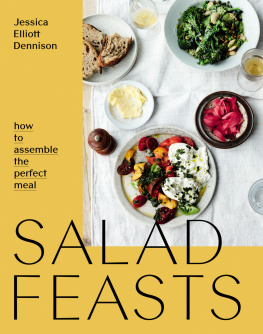
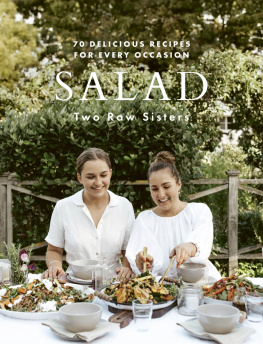

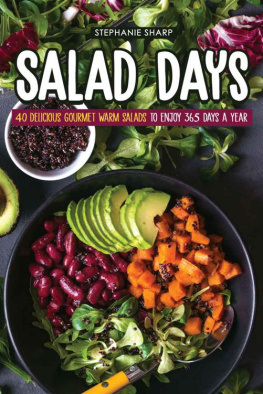

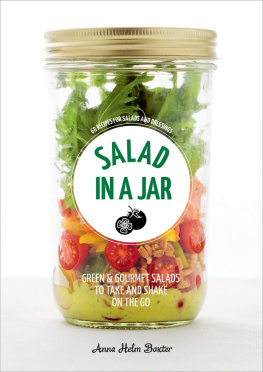


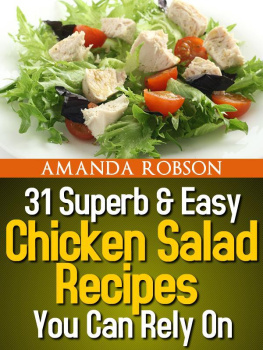


 contents Dedicated to Philip, Rosie, Ben and Jono. For it was your words of encouragement that led to the making of this book.
contents Dedicated to Philip, Rosie, Ben and Jono. For it was your words of encouragement that led to the making of this book.

 ASSEMBLE was the word that kept coming to mind when writing this book: the idea of taking a few good ingredients and tumbling them onto a big sharing platter, without the worry of complicated techniques or hard-to-find ingredients. This is my relaxed approach to connecting over food, which Ive combined with realistic guidance on how you can quickly build interesting flavours and textures in your everyday cooking. CHAPTER 1 guides you through my trusty go-to ingredients. These are the reliable tins of beans, nutty spice blends, fragrant dressings and bright pickles that I call upon to quickly elevate everyday vegetables into brilliant meals. The recipes in CHAPTERS 2 AND 3 are all generous, flavour-packed salads; each exciting and satisfying enough to be enjoyed as a main meal in its own right.
ASSEMBLE was the word that kept coming to mind when writing this book: the idea of taking a few good ingredients and tumbling them onto a big sharing platter, without the worry of complicated techniques or hard-to-find ingredients. This is my relaxed approach to connecting over food, which Ive combined with realistic guidance on how you can quickly build interesting flavours and textures in your everyday cooking. CHAPTER 1 guides you through my trusty go-to ingredients. These are the reliable tins of beans, nutty spice blends, fragrant dressings and bright pickles that I call upon to quickly elevate everyday vegetables into brilliant meals. The recipes in CHAPTERS 2 AND 3 are all generous, flavour-packed salads; each exciting and satisfying enough to be enjoyed as a main meal in its own right.  The wonderful thing about making a salad is that its a relaxed, stress-free way of cooking, with endless possibilities for customisation. However, to remove the guesswork from how Ive designed these recipes, Ive provided this loose template.By keeping these steps in mind and taking a look at the ingredient substitutes list, hopefully youll have the confidence to experiment and make these recipes your own.Pick Your Leading Vegetables Whats lingering in your fridge that needs using up? Whats cheap, in season and abundant in the shops and markets at the moment? Have a think about how youre going to treat your leading vegetable to make it that bit more special: Raw and shaved with a speed peeler to give it delicacy and shape? Raw and shaved with a speed peeler to give it delicacy and shape Roasted in a hot oven until intensely sweet and caramelised? Steamed or blanched, keeping it super-fresh and vibrant? Griddled or charred, imparting a deep, rich smokiness? Then give a thought to your additional vegetables and herbs: how can you chop or prepare them differently? Could you tear in whole herbs so that they take on the role of a salad leaf, or perhaps finely shred them, distributing their fragrance to lift the other ingredients? Pay attention to building contrast in colour and texture here. Consider whether a few different-coloured vegetables would make the dish look extra-inviting.
The wonderful thing about making a salad is that its a relaxed, stress-free way of cooking, with endless possibilities for customisation. However, to remove the guesswork from how Ive designed these recipes, Ive provided this loose template.By keeping these steps in mind and taking a look at the ingredient substitutes list, hopefully youll have the confidence to experiment and make these recipes your own.Pick Your Leading Vegetables Whats lingering in your fridge that needs using up? Whats cheap, in season and abundant in the shops and markets at the moment? Have a think about how youre going to treat your leading vegetable to make it that bit more special: Raw and shaved with a speed peeler to give it delicacy and shape? Raw and shaved with a speed peeler to give it delicacy and shape Roasted in a hot oven until intensely sweet and caramelised? Steamed or blanched, keeping it super-fresh and vibrant? Griddled or charred, imparting a deep, rich smokiness? Then give a thought to your additional vegetables and herbs: how can you chop or prepare them differently? Could you tear in whole herbs so that they take on the role of a salad leaf, or perhaps finely shred them, distributing their fragrance to lift the other ingredients? Pay attention to building contrast in colour and texture here. Consider whether a few different-coloured vegetables would make the dish look extra-inviting.